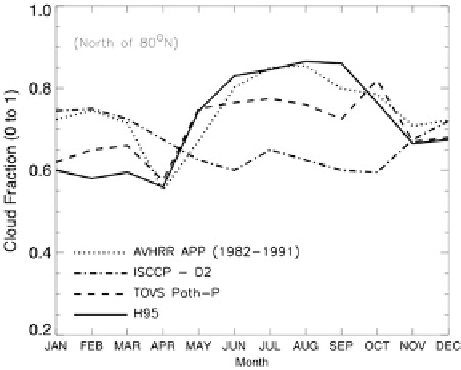Environmental Engineering Reference
In-Depth Information
Fig. 9.6
Annual cycle of
cloud fraction from surface-
based observations (H95) and
satellite retrievals (ISCCP-
D2, TOVS Path-P, and APP-
x) for the Arctic region north
of 80
N over the period
1982-1991 (Wang and Key
2005a
)
Key
2003
). The consistency of the APP-x products from different satellites over the
period of 1982-1999 was investigated and found no observable bias by Wang and
Key (
2003
).
Figure
9.6
shows an annual cycle of the total cloud fraction (cloud amount)
based on the surface observations (Hahn
1995
), the International Satellite Cloud
Climatology Project (ISCCP) D2 data set, the TOVS Path-P data set (Schweiger
et al.
1999
), and the extended AVHRR Polar Pathfinder (APP-x) data set. The
surface-based climatology does not include clear-sky ice crystal precipitation.
These low-level ice crystal clouds occur in winter about 20-50% of the time and
are often thick enough to have a significant radiative effect (Curry and Ebert
1992
;
Curry et al.
1996
), which should be considered in satellite retrievals of other Arctic
climate parameters. The APP-x data show that, as expected, the Arctic is one of the
cloudiest regions on the Earth with annual mean cloud coverage of about 70%.
About 70% of the clouds are in solid phase (ice) in winter, and about the same
proportion of the clouds is in liquid phase in summer. Mixed-phase and multilayer
clouds are not identified as such in APP-x. In winter more ice clouds occur over the
Arctic landmasses than the Arctic Ocean, with the particle sizes as large as 30
m.
Summertime clouds are predominantly liquid and equally distributed over the
landmass and ocean regions with the average particle size of 10
μ
m. In general,
visible cloud optical depth is about 5-6 for the Arctic overall. Optically thick clouds
occur in transition seasons for every region in the Arctic except the GIN seas where
thick clouds are in summer. The Arctic cloud top temperature basically follows the
surface temperature variation in space and time. Overall the cloud temperature is
lower than the surface temperature.
Cloud fraction has not changed significantly over the Arctic on an annual time
scale. However, APP-x shows that cloud cover has increased in spring and summer,
but decreased over the central Arctic Ocean in winter. Figure
9.7
shows the trends
in cloud particle phase, effective radius, and optical depth for four seasons and the
μ

Search WWH ::

Custom Search